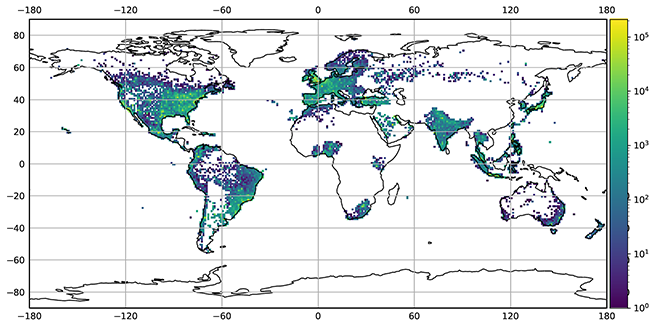
ここからコンテンツです。

Using big data to explore the principles of people's online activities globally
What is different or the same about online human connections Shiori Hironaka
A research team led by Shiori Hironaka, a project assistant professor in the Department of Computer Science and Engineering at Toyohashi University of Technology, has collected big data on social media across 10 countries and analyzed the relationship between the connections people make online and their behavior. As a result, they found that the follow ratio, which reflects the behavior of users, is common in each country. We believe that finding common features and differences in data that reflect the diversity of society will lead to the utilization of data that is tailored to the differences in each culture, such as marketing and effective information dissemination
The team collected data on the activities of more than 4,000,000 Twitter users in ten countries (Japan, the U.S.A., Brazil, the U.K., Philippines, Turkey, Indonesia, India, Mexico, and Saudi Arabia) and statistically analyzed the online relationships between the connections and behaviors of users. This is the first analysis of its kind in the world.
As more and more people use social media, ever increasing efforts are being made to use social media data for various surveys and analyses. This is because it is felt that social media data can provide an indirect perspective on the condition of society. However, even if the data on social media is gathered in identical fashion, the nature of the data will still vary by country due to cultural differences and other factors. This is because user behaviors are generally considered to reflect the cyberculture of the group to which they belong. Therefore, if we are to make effective use of social media data for research purposes, we should first try to understand its characteristics.
In this study, we focused on the proximity of users to each other's activity areas and analyzed the connections among users. This is because we believe that the purpose of social media use is closely related to the proximity of activity areas between the people connected on social media. For example, users who use social media to interact with friends are more likely to be close to each other, while users who use social media to post about celebrities or subscribe to news are less likely to be close to each other. We examined the relationship between the proximity of the area of activity and the behavior of users on social media, and compared the characteristics of each country.

As a result, we found a common feature among the 10 countries that is related to the proximity of the user's area of activity. This characteristic is called the follow ratio, which is the ratio of the number of accounts a user is following to the the number of followers of the user themself. A user with a large follow ratio is considered to be a subscription-oriented user. We also found that the longer the user's profile is, the farther from home the action area tends to be, but this finding was not replicated across all ten countries.
Essentially, data on social media connections can express information about users around the world in the same way. However, this may not ensure the expected precision for such functions as friend recommendations and attribute estimations as the nature of the data individually differs due to cultural differences. The characteristics identified by this analysis are expected to help provide the best information to users of different countries and cultures.
For future research, the aim of the research team will be to examine the characteristics of social media big data in more detail, so as to clarify the cultural differences in the use of social media, and to contribute to the development of the next-generation social media.
This research project was sponsored by JPMJMI20B4, a JST-Mirai Program.
References
Shiori Hironaka, Mitsuo Yoshida and Kyoji Umemura (2021).
Cross-Country Analysis of User Profiles for Graph-Based Location Estimation.
IEEE Access, doi: 10.1109/ACCESS.2021.308652.
https://ieeexplore.ieee.org/document/9446911
ビッグデータで世界の人々のオンライン活動の原理に迫る
オンライン上の人々が作るつながりの相違点と共通点廣中 詩織
豊橋技術科学大学情報・知能工学系 廣中詩織特任助教の研究チームは、ソーシャルメディア上で世界10カ国にわたるビッグデータを収集し、人々がオンライン上で作るつながりとふるまいとの関係を分析しました。その結果、ユーザーのふるまいを反映するフォロー比が各国で共通するという特徴を発見しました。社会の多様性が反映されたデータの中で、共通の特徴や違いを見つけることは、それぞれの文化の違いに合わせたデータの活用、例えばマーケティングや効果的な情報発信等につながると考えています。
研究チームは、10カ国(日本、アメリカ、ブラジル、イギリス、フィリピン、トルコ、インドネシア、インド、メキシコ、サウジアラビア)にまたがる400万を超えるユーザーのTwitter上での活動データを収集し、統計処理を用いて、オンライン上で作るつながりとユーザーのふるまいの関係を分析しました。これは世界初の分析となります。
多くの人々がソーシャルメディアを利用するようになったことで、ソーシャルメディアデータを様々な調査や分析に利用する取り組みが増えてきています。これは、ソーシャルメディアデータが社会の様子を間接的に観測しているとみなされているからです。しかし、同じようにソーシャルメディア上で観測されたデータであっても、国ごとに異なる文化やその他の様々な要因によってデータの性質が変化します。ユーザーのふるまいには、そのユーザーが属している集団でのオンライン文化が反映されていると考えられるからです。以上より、ソーシャルメディアデータを様々な調査に利用するためには、その特性を知ることが重要です。
本研究では、ユーザー同士の活動地域の近さに着目し、ユーザー同士のつながりを分析しました。ソーシャルメディア上でつながっている相手との活動地域の近さには、ソーシャルメディアの利用目的が密接に関わると考えられるからです。例えば、友人との交流に利用する場合は活動地域が近くなりやすく、有名人などの投稿やニュースのフォローを目的とする場合は活動地域の近さとあまり関連がありません。活動地域の近さと、ソーシャルメディア上でのユーザーのふるまいとの関係を調べ、その特徴を国ごとに比較しました。
その結果、活動地域の近さと関係するユーザーの特徴として、10カ国間での共通点を発見しました。その特徴はフォロー比というもので、ユーザーがフォローしている数のフォローされている数に対する比です。フォロー比が大きいユーザーは情報収集目的のユーザーだと考えられます。その他には、自己紹介文が長いと活動地域が遠い傾向にあるなどの発見がありましたが、10カ国間で共通な特徴と判断するには至りませんでした。
本来、ソーシャルメディア上のつながりのデータは、世界中のユーザーを同じように表現することができるものです。しかし、文化などの違いによって、データの性質が異なることで、友達推薦や属性推定などの機能に期待される精度が出ない場合があります。今回発見された特徴から、国や文化の異なるユーザーに、最適の情報を提供することが可能になると期待できます。
研究チームは、ソーシャルメディア上で観測されるソーシャルメディア上のビッグデータの性質をより詳細に調べることで、ソーシャルメディアを活用する文化の違いを明らかにし、次世代ソーシャルメディア創出のための手がかりの解明をめざします。
本研究は、JST未来社会創造事業、JPMJMI20B4の支援を受けたものです。
Researcher Profile

| Name | Shiori Hironaka |
|---|---|
| Affiliation | Department of Computer Science and Engineering |
| Title | Project Assistant Professor |
| Fields of Research | Social Network Analysis, Computational Social Science |
| Graduated KOSEN |
National Institute of Technology, Tokuyama College |
ここでコンテンツ終わりです。
